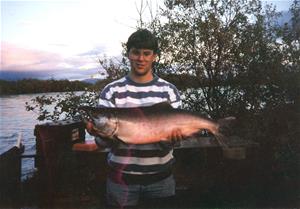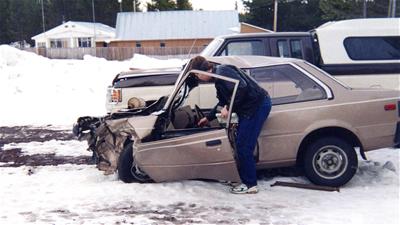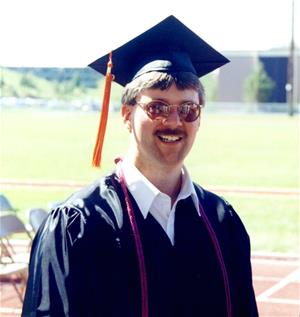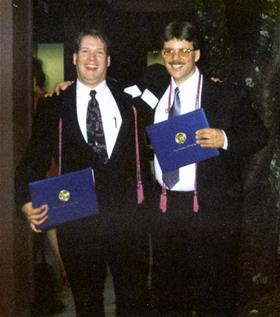Jason Sullins grew up in rural Boring, Ë¿¹ÏÊÓƵ, as a third-generation Ë¿¹ÏÊÓƵian. Raised in the country, much of Jason's childhood was spent building things, inventing, and working in construction with his father, which cultivated much of the creativity and resourcefulness used later in his engineering career. Growing up well below the poverty level, Jason took it upon himself to build a college savings account. Working nearly full-time as a laborer throughout high school to save money for college, Jason also spent a few summers working in the remote Eskimo village of Togiak, Alaska, in construction. He graduated from Sandy Union High School as the class of 1990 valedictorian, one of the top high school students in Ë¿¹ÏÊÓƵ.

Jason first learned about Ë¿¹ÏÊÓƵ Tech in 1991 through connections in the Electronic Systems Technology (EST) program at Mt. Hood Community College. While in the EST program, he participated in industrial leadership programs and was an active member of VICA (Vocational Industrial Clubs of America). Also, during that time, he received an internship with Rapitron International (DBA Skyline Radio), an FAA Avionics repair station. The skills he learned and the mentorship he received laid the foundation for his engineering career. Equipped with an associate's degree and a job he enjoyed as an Avionics (aircraft electronics) Technician, Jason made the difficult decision after three years to leave this position and move to Klamath Falls to pursue his dream of earning a bachelor's degree.
With so many schools out there, Jason chose to attend Ë¿¹ÏÊÓƵ Tech because its electronics programs had the most industry-relevant content. As Jason explained, "I care about results, and Ë¿¹ÏÊÓƵ Tech is all about getting results by imparting the right skills needed to succeed in the high-tech industry." Jason joined the International Students club while attending Ë¿¹ÏÊÓƵ Tech at the Klamath Falls campus. He enjoyed the diversity of fellowship with engineering students from all over the world. Many international students commented that Ë¿¹ÏÊÓƵ Tech was far more renowned internationally than in the U.S. or even locally in Ë¿¹ÏÊÓƵ. He also appreciated that Ë¿¹ÏÊÓƵ Tech students were serious and highly focused on academic success with a clear vision of their future professional goals.
During Jason's junior at Ë¿¹ÏÊÓƵ Tech, in January of 1997, he and a classmate were returning to Klamath Falls after spending winter break at home. Jason's 1984 Nissan Sentra had just made it over the Willamette Pass and began driving on dry pavement on the last stretch of HWY 58 before the turn-off onto HWY 97. Without a car in sight for miles around them except a large, king-cab pickup in the oncoming lane, the worst possible scenario unraveled in a fraction of a second. The truck swerved into their lane, and the vehicles collided at a combined speed of over 100 MPH. The college students were life-flighted to St. Charles Medical Center, where Jason spent the first week of winter term in the ICU on a morphine drip. After having surgeries to repair damage to his nose and eye socket, Jason went directly from the hospital back to campus, determined to stay on schedule at school and maintain his academic performance.

During Jason's senior year at Ë¿¹ÏÊÓƵ Tech, he transferred to the Portland-Metro campus (which at that time was located on Harmony Road), for the opportunity to take the ASIC (Application Specific Integrated Circuit) design specialization option. Students designed, tested, and prototyped integrated circuits (ICs) in this program. Through the MOSIS program, students could fabricate their designs into physical chips. Since Jason's IC design was relatively complex, he did not have the extra time to follow through with the final steps to go to fabrication. Years later, a semiconductor company designed and sold a nearly identical IC, which generated millions of dollars in revenue. The success of the IC that was similar to Jason's capstone project demonstrates the relevancy of Ë¿¹ÏÊÓƵ Tech’s curriculum in today’s industry. Jason graduated with a 4.0 GPA in 1998, on schedule.


(Klamath Falls graduation) (Portland-Metro graduation)
Jason explains, "After finishing my undergraduate studies and reentering the high-tech industry, I learned the value of my Ë¿¹ÏÊÓƵ Tech training. I used nearly all of the content of almost all my Ë¿¹ÏÊÓƵ Tech classes in the engineering roles I served throughout my career. Ë¿¹ÏÊÓƵ Tech is the university that is designed for industry, by industry." Jason worked at Maxim Integrated for over 22 years and is completing his final thesis work towards a Master's of Science in Electrical Engineering at Ë¿¹ÏÊÓƵ Tech while also starting his own company, Integrity Circuits LLC. The tagline for Integrity Circuits reads, "Engineering lower cost and higher performance solutions through innovation and persistence." Jason provides custom design, prototyping, and fabrication of electronic circuits and systems for a wide range of applications. Services include hardware and software development, schematic capture, PCB layout, fabrication, and assembly, mainly for the automotive, renewable energy, and telecommunications industries.
Philanthropy and making a positive difference are very important to Jason. In addition to financial gifts, Jason has been giving back by being directly involved with the electrical/electronic and renewable energy engineering programs. Over the last four years, he has had the opportunity to participate in industry advisement, course curriculum, and student mentoring. He has also served as a graduate assistant and utilized his three decades of industry experience to teach an electronics course in Printed Circuit Board (PCB) design. Jason has set a goal to help make Ë¿¹ÏÊÓƵ Tech a "PCB Design Center of Excellence." This initiative thus far is threefold and includes enhancements to Ë¿¹ÏÊÓƵ Tech's PCB design class (EE485/EE585), the creation of a PCB and Circuit Design support website, and mentoring sessions from industry experts. Additionally, the newly installed freeway signs for Ë¿¹ÏÊÓƵ Tech along the I-5 freeway in Wilsonville are thanks to Jason's generosity and years of determination to put the Portland-Metro campus on the map.
Jason has endless words of wisdom and gems of advice to share with current and future students of Ë¿¹ÏÊÓƵ Tech. A few of these include:
- Choose your degree major and career path considering your personality type and try to work within your strengths.
- From the long-term perspective, your academic career will be the highest "paying" job you will ever have. Do not let your job or outside influences compromise your studies. Extract every ounce of content out of your classes. Your hard work will pay off.
- Actively seek out mentors. Although mentorship has become primarily lost in our current society, many professionals (myself included) are willing to share their years of experience and training.
- Give back to Ë¿¹ÏÊÓƵ Tech when you are in a position to do so. Perhaps as true as Ohm's Law is the "Law of Engineering Karma," which holds that you are likely to get more in return when you donate or pass on knowledge.








